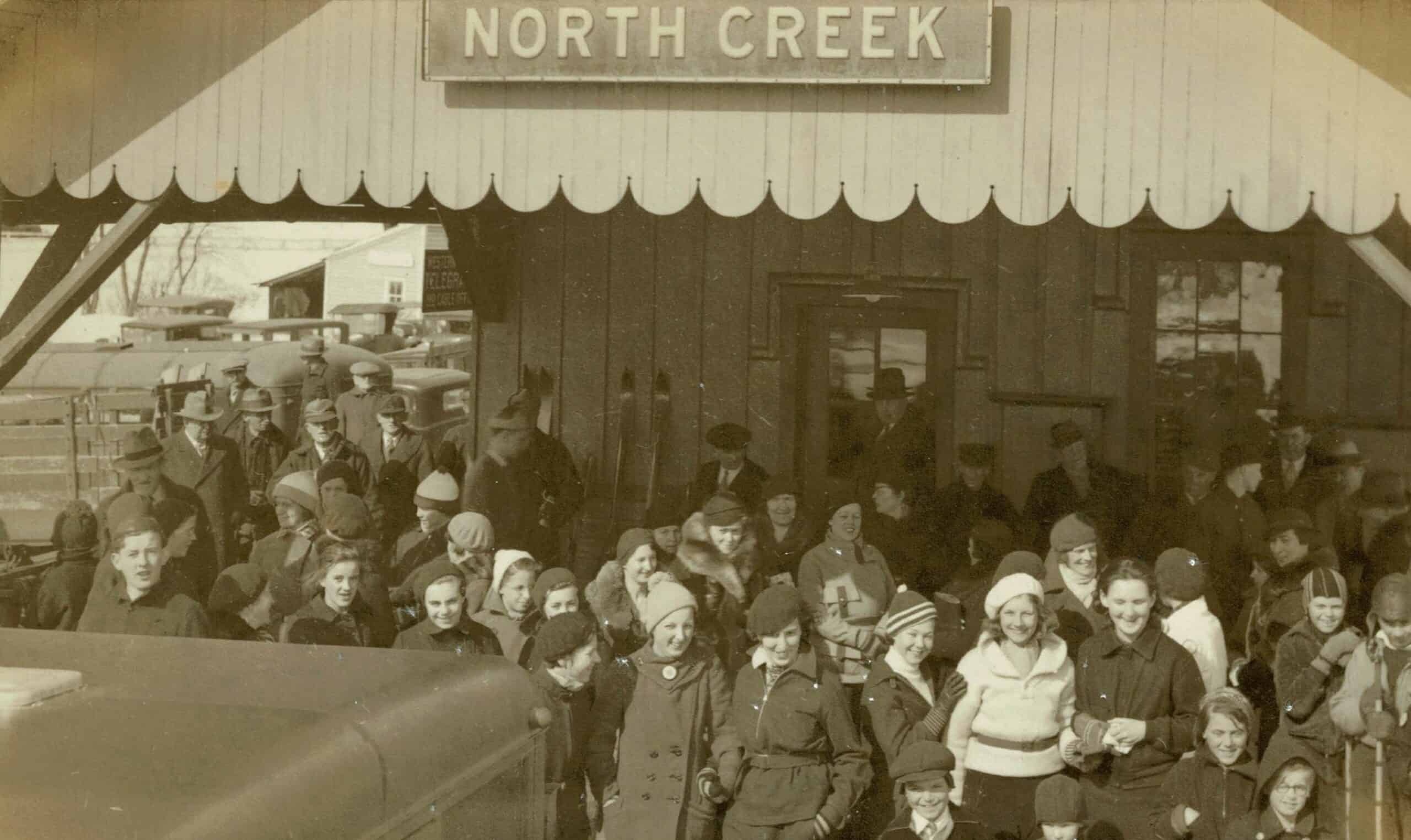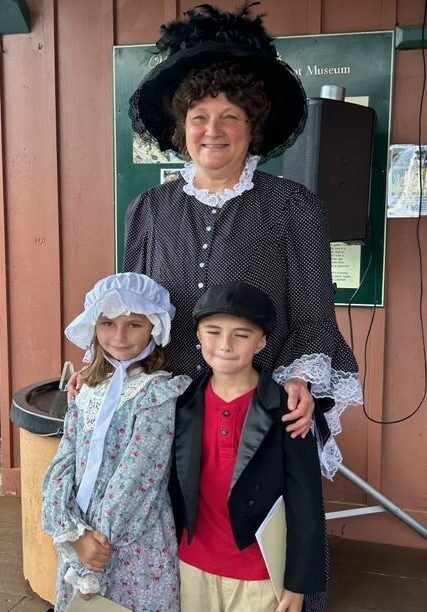Admission is FREE
About The North Creek Railroad Station
Listed on the State and National Registrar, the North Creek Railroad Station Complex is located in the hamlet of North Creek in the Town of Johnsburg, Warren County, New York. It is in the southeast portion of the Adirondack Forest Preserve with more or less rural lands to the south and east. The railroad line hugs the western shore of the Hudson River, traversing North Creek on its way to Tahawus. The station complex is at the northern end of the hamlet on the west bank of the Hudson River.
The complex also includes the restored freight house and engine house that are currently occupied by the railroad, a sand tower, and a ninety-foot turntable.


Mission Statement
The North Creek Railway Depot Preservation Association collects, preserves, and interprets objects related to the history and culture of the Greater Gore Mountain Region. It makes those objects and their interpretation available to the public through the operation of the
North Creek Depot Museum with its educational exhibits and programs.
We focus on several areas of historical interest: Theodore Roosevelt and his “Night Ride to the Presidency” in North Creek, Dr. Thomas Durant and the “Adirondac” Railroad that he built from Saratoga to North Creek (1866-71), and the early ski pioneers that built and developed the Historic Ski Trails in the Greater Gore Mountain Region. Along with our
exhibits, we also have a model train diorama that represents the region from the early to mid-20th century.


Architecture
Architecturally, the depot is a fine example of the typical rural station of the period. The North Creek station has remained almost completely unaltered since the day it was built in 1872. The whole complex, consisting of the depot, the freight house, round house, tool house, turntable and horse barn, is remarkably intact and provides an interesting record of railroad history.
The depot is a simple, rectangular, gable-roofed building with the broad overhanging, strut-support roof popularly associated with late 19th century railroad architecture. The exterior of this “stick style” building is covered with vertical boards with batten strips. The tall narrow window sash has 2/2 lights with label moldings. A gable-roofed porch that shelter the station platform is attached to the station. Like the station, this porch is executed in the “stick style” idiom with notched rafter ends and a border of scallops at the gable end.
History
Historians remember the North Creek Railroad Station as the place where Theodore Roosevelt on September 14, 1901 learned of the death of President McKinley and of his own succession to the Presidency of the United States. In addition to this well-known story, the station deserves attention for its role as the northernmost terminus of the Adirondack Railroad, a line that played an indispensable role in making the central Adirondacks accessible for recreational and industrial development. The complex is also noteworthy in that it preserves (in microcosm) an intact collection of structures associated with railroad history.
In the middle of the 19th century, the Town of Johnsburg was a sparsely settled, remote, mountainous wilderness. As was the case throughout the Adirondacks, the lumber industry and tanneries formed the chief economic base of the community. The Adirondack Company line was extended to North Creek in 1871 to link the north and central parts of the state to facilitate shipping of essential goods and local products.
Dr. Thomas C. Durant, Vice President of the Union Pacific Railroad Company, was anxious to promote his recreational and industrial ventures in the Adirondacks, so he purchased the assets of what was then known as the Adirondack Estate and Railroad Company. Earlier companies associated with this north-south route were the Sackets Harbor and Saratoga Railway Company and the Lake Ontario and Hudson River Railroad Company. Now reorganized once again as the Adirondack Company, Durant made plans to run the line from Saratoga to Ogdensburg. However, after the bed had been completed from Saratoga to North Creek (1871), activity ceased.





Tourism
Although the railroad supplied transportation for area industries, especially the garnet mine, tannery and Durant’s woodworking plant at North Creek, its greatest use became the transporting of summer visitors. In the early days of the railroad, William West Durant operated a stage line from North Creek to the hotels at Blue Mountain Lake. Horses for the stage were stabled in the large barn still located next to the original railroad station built in 1872. At the same time a freight house was also constructed.
In 1889 the Delaware and Hudson Canal Company purchased controlling interest in the Adirondack Railroad Company from Durant. The operation of the line remained under local operation until 1902 when the line merged with the existing D&H system and became known as the Adirondack Branch of the D&H Railroad.
The Adirondack Branch survived the Great Depression due in part to the ski trains that ran from Schenectady and New York City in the 1930′s. Skiers flocked to North Creek and to the first downhill ski center in New York State, which was constructed at the Ski Bowl on the slopes of Gore Mountain. The 1940′s brought the outbreak of World War II and the end of the short-lived ski trains. A low-grade iron mine in the area of Tahawus, just north of Newcomb, had been discovered to be one of the largest known deposits of the element titanium. This material was of vast importance to the war effort. After great debate over the possibility of extending the line over constitutionally protected Forest Preserve, the line was extended to Tahawus for the purpose of transportation of titanium for wartime use. The 33-mile section of the rail from North Creek to Tahawus took two years to complete and was operational by 1944.
Preservation
The North Creek station remained in use until 1989. The demise of the tanneries, and a decline in tourism and in the demand for titanium from the mine (NL Industries) at Tahawus, forced its closing. In 1991 the Canadian Pacific Railroad acquired the North Creek rail yard. It sat vacant and abandoned, no longer in use due to the lack of commercial value. Canadian Pacific’s interest was in the main railroad line. Meanwhile the buildings were left to rot. At that time the North Creek Railway Depot Preservation Association (NCRDPA) was formed in order to acquire the depot and rescue it from further deterioration. Canadian Pacific deeded the station building to NCRDPA on February 25, 1993.
While railroad history buffs may admire the intact state of this railway complex, most persons know of the North Creek station as the site where Vice President Theodore Roosevelt learned that he had become President.
Today the Depot serves as a fully accredited Museum of the History and Culture of the Gore Mountain Region.
To find more activities, lodging, restaurants and shops, visit Adirondack.net and LakeGeorge.com
